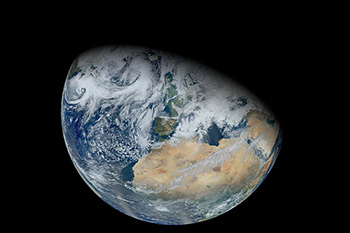

By John Karoly
Chicago, IL, USA

John Karoly
Last month Scientific American put their usual historical look back on science and technology "50,100 and 150 years ago" on its head and posed the question: "What will science, technology and the future look like 50,100 and 150 years from today?" Various scientists and engineers contributed articles that talked about how we will live, commute, communicate and travel in space, and about advances in computer technology, etc. They looked into the future 50, 100 and 150 years down the road using their best knowledge. However, by necessity this knowledge is still encored in the early part of the 21st century and we have a demonstrated inability to shake that bias. As Yogi Berra wisely remarked, "It is difficult to make predictions, especially about the future." Admittedly some of these forecasts had a sense of reality and others sounded utopist. While not totally pessimistic in predicting a catastrophic event, one author contemplated the global politics after the first nuclear war that killed a billion people.
However, my focus was more on space travel. The Scientific American look at space was followed by an event at The California Institute of Technology (Caltech) titled, "Science and the New Space Race." This brought together an enthusiastic audience of mostly Caltech students and professors, NASA panel member, Dr. John Grunsfeld, with an impressive scientific and space flight career, Caltech and George Washington University professors and executives from Virgin Galactic and Space X, the two commercial space travel companies.
As I said, the audience was enthusiastic. When asked how many of us want to travel to space, almost everyone's hand went up. Mine was not among them. Much of the point of the meeting was to look into commercial space travel in the future and how it can be made more accessible to a much larger crowd than the current one. If you want to go to space, evidently the Russians will take you there for a mere 60 million dollars. Virgin Galactic and Space X, among other commercial enterprises, hope to beat this price by a large factor. Unfortunately this factor is not really known, but the major thrust of the current work is to reduce the cost of hurdling into space, against the earth's gravity, a mass of machinery and humanity.
And, one more event that took place in early January. We took our grandson, who just turned six, to the Endeavour exhibit at the Los Angeles Science Museum. He loved it, could not get enough of it and was taken by the IMAX 3-D show of endless space, the repair of the Hubble space telescope and other space flights. We discussed many aspects of the shuttle together and spent several minutes looking at the Endeavour toilet. We agreed that one should not contemplate a hasty trip to space; this toilet requires the ultimate potty training. Nevertheless, if our grandson would have been present at the Caltech event, I am certain his hand would have been raised. I am sure he wants to go to space.

(credit: NASA)
So why did my hand stay in my lap? For sure I would enjoy the fantastic views of the Earth a spaceflight has to offer. I imagine, like most others, that it would be a tremendous experience, as we saw countless numbers of times on videos taken by astronauts. Still, these trips could be only considered sightseeing in near-earth orbit, not really space travel. It might make the commercial companies viable, but could not be considered part of space exploration. Leaving earth's orbit can take us around the solar system within a human lifetime, if you are rather young at the start of the journey. You can go to a single location like Mars, land there and help colonize it, but to what end? Would I really want to spend any time on Mars? Certainly not. As Curiosity and other Mars vehicles have shown, it is a terribly unfriendly landscape. It is fascinating to explore by robotic means, but for humans to spend any time there would mean either to get a lot of radiation on the surface or to live underground like a mole.
Traveling into deep space means to live on a space ship, described in the Scientific American article in some detail, living with cows and other animals with a thousand or so humans, being born on the ship and dying on it for generations - never to see the good old earth again. I could have some interest to orbit some of the other planets from a respectable distance, but after leaving the solar system, there will be nothing exciting, I imagine, for many generations of human life - maybe for thousands or hundreds of thousands of years unless we can develop propulsion that will allow us to accelerate to some significant fraction of the speed of light. At any rate, I will not be present but maybe one of my very distant descendants will be there to find another planet nearby another star.
I prefer to stay here on Earth, the most beautiful spot in the accessible Universe. If I build up enough courage and manage to overcome my claustrophobia and they can lower the price of a few days' earth orbit, I will consider taking one of those commercial flights. But that will not make me an astronaut or an enthusiastic scientific space traveler. I firmly believe that leaving earth's orbit should be left to robotic computers that don't need to be fed, don't die from exposure to radiation, don't atrophy in the reduced gravity of Mars, don't scream, "I want to go home" and don't need to use a potty. They can travel and send us pictures and information of what they find. We humans should stick around here and enjoy our beautiful planet that teaches us to take good care of it because there is no replacement for it, at least none we can reasonably get to.




